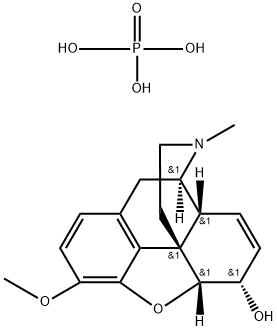Chemical Properties
White or almost white, crystalline powder or small, colourless crystals.
Originator
Actacode Linctus,Sigma
Uses
Antitussive; analgesic (narcotic).
brand name
Ambenyl
Cough Syrup (Parke-Davis); Colrex Compound (Solvay
Pharmaceuticals).
Therapeutic Function
Narcotic analgesic, Antitussive
Clinical Use
Codeine is used extensively to treat moderate to mild pain. Codeine is a weak μ agonist, but
approximately 10% of an oral dose (30–60 mg) is metabolized to morphine, which contributes significantly to its analgesic effect. The plasma
half-life of codeine after oral dose is 3.5 hours. The dose of codeine needed to produce analgesia
after parenteral dose causes releases of histamine sufficient to produce hypotension, pruritus, and
other allergic responses. Thus, administration of codeine by parenteral route is not recommended.
Veterinary Drugs and Treatments
In small animal medicine, codeine is used principally as an oral
analgesic
when salicylates are not effective and parenteral opiates
are not warranted. It may also be useful as an antitussive
or an
antidiarrheal.
Drug interactions
Potentially hazardous interactions with other drugs
Antibacterials: metabolism increased by rifampicin.
Antidepressants: possible CNS excitation or
depression with MAOIs - avoid concomitant use,
and for 2 weeks after stopping MAOI; possible
CNS excitation or depression with moclobemide;
increased sedative effects with tricyclics.
Antihistamines: increased sedative effects with
sedating antihistamines.
Antipsychotics: enhanced hypotensive and sedative
effects.
Dopaminergics: avoid with selegiline.
Nalmefene: avoid concomitant use.
Sodium oxybate: enhanced effect of sodium oxybate
- avoid.
Metabolism
Codeine is metabolised by O- and N-demethylation in
the liver to morphine, norcodeine, and other metabolites
including normorphine and hydrocodone. Metabolism to
morphine is mediated by the cytochrome P450 isoenzyme
CYP2D6, which shows genetic polymorphism.
Codeine and its metabolites are excreted almost entirely
by the kidney, mainly as conjugates with glucuronic acid.


